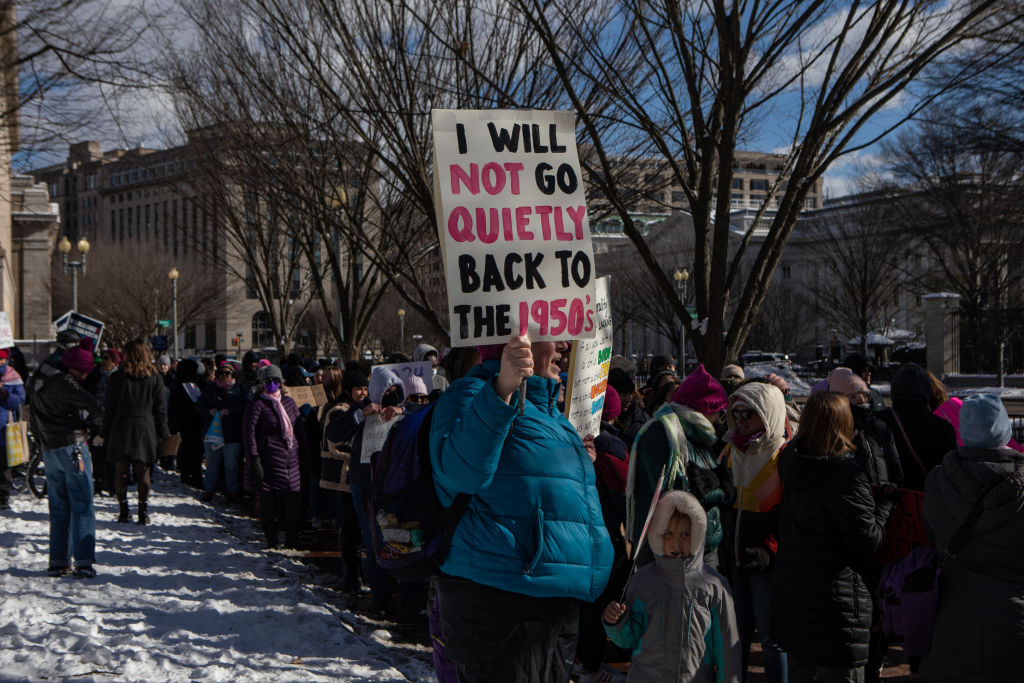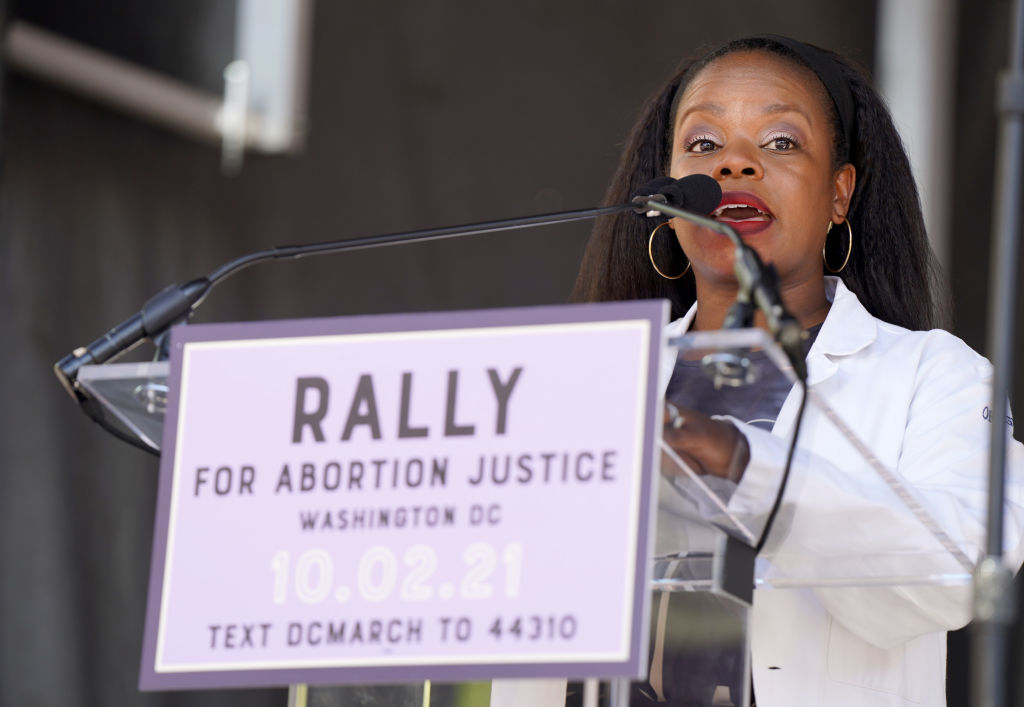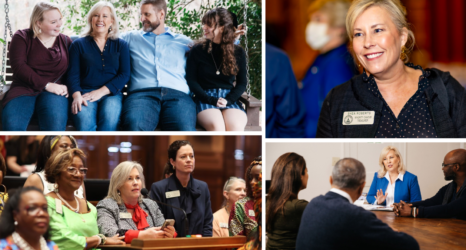
On May 1, 2022, the day before the Dobbs decision was leaked, the average American was 25 miles from an abortion clinic. Within one year, 23 percent of Americans were farther from the nearest abortion clinic than they were before Roe was overturned. The average person who experienced an increase in distance from the nearest clinic was, as of last year, over 300 miles from the nearest abortion provider.
Caitlin Knowles Myers, a professor of economics at Middlebury College who tracks the impact of abortion restrictions on access to brick-and-mortar clinics, brought these statistics to life during “Reproductive Health Care in Post-Roe America,” a panel in August on the ever-shifting reproductive health landscape hosted by the USC Annenberg Center for Health Journalism. Myers was joined by Dr. Jamila Perritt, an OB-GYN who serves as the CEO of Physicians for Reproductive Health, and Kate Zernike, a national New York Times correspondent who covers, among other things, shifting attitudes on abortion.
The three panelists talked about the post-Dobbs period as one that will feature tens of thousands of forced births purely because of clinic closures—many abortion seekers will be too far away from the ones that remain open. Access is further interrupted, they said, by court decisions so confusing that providers do not know if and when they can legally dispense abortion medication or intervene with abortion care to save lives.
Ms. revisits this webinar on the 51st anniversary of Roe, at a time when public opinion on abortion grows increasingly favorable—it continues to win elections—but the threat of losing access to care persists everywhere: No state is safe.
Distances Impossible to Bridge
While many of the post-Dobbs consequences are still unknown, “we know that abortion legalization 50 years ago allowed women, particularly young women, particularly women of color, to avoid severely mistimed entrance to motherhood and often marriage,” Myers said. “As a result, we’ve been able to see statistically that they were much more likely to be able to finish their education, avoid poverty [and] enter higher paying jobs.”
Because we know what happened after Roe, “we have a pretty good idea of what’s gonna happen now that it’s been overturned,” Myers said.
Probably 78 percent of people—three quarters of people who want abortions—are able to find a way to get out of these ban states and reach a facility. That leaves about a quarter unable to get out.
Caitlin Knowles Myers
What Myers does not know, she can predict. As she monitors how Americans’ distance from the nearest abortion facility is changing—using her Abortion Access Dashboard —she can estimate how distances increase as abortion restrictions worsen. Using the Guttmacher Institute’s forecast of states likely to further restrict or ban abortion, Myers anticipates that 44 percent of Americans will find themselves even farther from abortion facilities than they are now.
“My prediction is that about probably 78 percent of people—three quarters of people who want abortions—are able to find a way to get out of these ban states and reach a facility. That leaves about a quarter unable to get out,” she said. “I think that is a big number. That is, in these areas, a significant fraction of people who want to access healthcare who are unable to reach a provider.”
Myers estimated that, if the Guttmacher predictions hold,
- Every year, 78,000 people who want abortions and would have been able to get them pre-Dobbs will no longer be able to reach facilities simply because they are too far away.
- As a result, every year 55,000 of these individuals will end up giving birth.
Ideally, your care should be provided by someone who lives and works in your community, who’s familiar with you, who speaks your same language, ideally who looks like you, has shared lived experiences.
Dr. Jamila Perritt

A paper Myers published with Daniel Dench and Mayra Pineda-Torres in November, “The Effects of the Dobbs Decision on Fertility,” further suggested that Black and Hispanic women and women in their twenties are overrepresented in the increase in births in states with abortion bans post-Dobbs.
Even when facilities are available, abortion providers may not be. As Perritt explained during the webinar, she and her colleagues will try to bridge the distance. “I’m traveling longer distances to take care of people,” she said. “We heard [Professor] Myers talk about the distance that people travel to be able to get this care. … It’s also shaped the behavior of abortion providers.”
But, she said, “That is a Band Aid solution, right, it isn’t the ideal way to provide healthcare. Ideally, your care should be provided by someone who lives and works in your community, who’s familiar with you, who speaks your same language, ideally who looks like you, has shared lived experiences. That is the way we see improved health outcomes for folks, not me flying into a community that I’m not grounded in, that I’m not familiar with, taking care of people. But here we are.”
An Environment of Chaos and Confusion
As abortion restrictions interrupt physical access, they create uncertainty around whether any access is legal. “Every ban that is passed—every restriction that is passed on abortion—is designed to eliminate all abortion,” said Perritt, “Period. That is the end goal.”
Any restriction, therefore, is “designed to cause chaos and confusion,” she said, such that it “thrusts people into this limbo in an extremely stressful situation, trying to navigate a system that is set up for them to fail.”
Perrit pointed to the Alliance for Hippocratic Medicine v. FDA litigation; the most recent decision by the Fifth Circuit would severely interrupt access to mifepristone, but it will not take effect until the Supreme Court reviews and issues its decision on the case. “We get calls frequently—the doctors in our network are often talking about this—that folks are calling clinics, calling their offices” said Perritt. They ask, “Is it still legal to get this medication? Can I still obtain it in this state? In this place? In your practice?”
Even physician associations have started to speak out about the dangerous lack of certainty, said Zernike. “The AMA is now coming out and saying this has caused, in their words, chaos in hospitals. And that has been huge. Doctors are stepping up and saying… ‘we are being forced into the position where we have to think of the law first and medicine second.’”
Republican voters—anti-abortion voters—are much less likely to vote on this issue. They’re sort of walking away from the issue.
Kate Zernike
Notably, associations like the AMA have not always been supportive of abortion access. “If you look back to the, long before, like the late 19th century, the AMA was actually pushing [for] abortion restrictions,” Zernike said. After all, Perritt added, “Black midwives in the South were controlling this care.” Abortion restrictions allowed “doctors who are almost exclusively white men to be able to corner the share of the market.”
The shift in the AMA’s position, Perritt said, was the direct result of physician organizing. “We’ve seen similar changes with the [American College of Obstetricians and Gynecologists]. It is not the good nature of people in leadership that causes this to happen—it’s the pressure from grassroots on grass tops that makes this a reality.”
The ground is shifting on a grander scale, said Zernike. Abortion is increasingly understood as healthcare, and the number of people who believe abortion should be illegal in every case is consistently low. “What we’ve seen since Dobbs,” she said, “is that it really motivated Democratic voters and, in fact, Republican voters—anti-abortion voters—are much less likely to vote on this issue. They’re sort of walking away from the issue.”
Even so, the danger of losing access to reproductive healthcare is omnipresent, particularly for those already experiencing marginalization. And although most restrictions seem concentrated in red states, Perritt urged everyone “to understand, regardless of whether or not you live in D.C. or you live in New York or you live in California, no place is safe. No state is safe. And we can see very clearly that when one domino falls, the rest [are] not far behind.”
Watch the full webinar here.
Up next:
U.S. democracy is at a dangerous inflection point—from the demise of abortion rights, to a lack of pay equity and parental leave, to skyrocketing maternal mortality, and attacks on trans health. Left unchecked, these crises will lead to wider gaps in political participation and representation. For 50 years, Ms. has been forging feminist journalism—reporting, rebelling and truth-telling from the front-lines, championing the Equal Rights Amendment, and centering the stories of those most impacted. With all that’s at stake for equality, we are redoubling our commitment for the next 50 years. In turn, we need your help, Support Ms. today with a donation—any amount that is meaningful to you. For as little as $5 each month, you’ll receive the print magazine along with our e-newsletters, action alerts, and invitations to Ms. Studios events and podcasts. We are grateful for your loyalty and ferocity.





